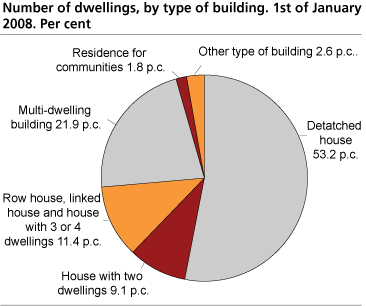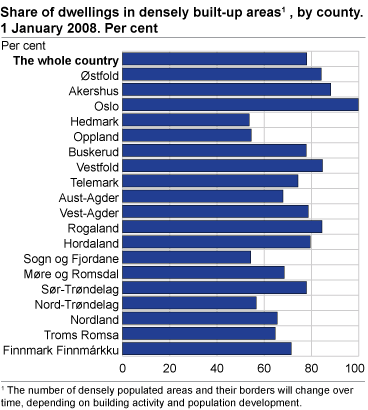Content
Published:
This is an archived release.
Almost 500 000 flats in multi-dwelling buildings
Due to the strong increase in the building of multi-dwelling buildings over the last years, there were almost 500 000 flats in multi-dwelling buildings at the first of January this year. More than 75 000 of these are constructed during the last seven years.
There were a total of 2 274 362 dwellings in Norway at the first of January 2008, with 53 per cent being detached houses. Flats in multi-dwelling buildings followed at 22 per cent, while dwellings in row houses, linked houses and houses with three or four dwellings accounted for 11 per cent. Dwellings in houses with two dwellings accounted for 9 per cent and dwellings in residences for communities accounted for 2 per cent of all dwellings. The last 3 per cent of the dwellings are registered in buildings where the main part of the floor space is used for other purposes than dwellings, mainly industrial buildings.
Largest increase in flats
As much as 15.1 per cent of the flats in multi-dwelling buildings, 75 000 units, were constructed in the period from 2001 to 2007. In comparison, only 5.3 per cent of the 1.2 million detached houses were built during this period.
Both apartments and bed-sits are counted as dwellings. For the time being, the statistics does not distinguish between occupied and vacant dwellings, and therefore include all dwellings registered as active in the Ground Parcel, Address and Building Register (GAB)/Matrikkelen.
31 000 multi-dwelling buildings
The 498 592 flats in multi-dwelling buildings are located in a total of 30 950 buildings, giving an average of 16 flats in each multi-dwelling building. As many as 10 187 of the multi-dwelling buildings are in Oslo, with an average of 22 flats in each building. In comparison, the average in Finnmark is eight flats.
All residential buildings with two storeys or more and with a minimum of five dwellings are defined as multi-dwelling buildings.
4 out of 5 dwellings in densely built-up areas
78.0 per cent of the dwellings in Norway are located in densely built-up areas. In Oslo, 99.8 per cent of the dwellings are in densely built-up areas, whereas 88.2 per cent of the dwellings in Akershus are located in such an area. At the other end of the scale are Hedmark, Sogn og Fjordane, Oppland and Nord-Trøndelag - all with approximately 55 per cent of the dwellings in densely built-up areas.
Comparability with the Housing Census in 2001The register based dwelling statistics can not be compared directly with the Housing Census in 2001 . The Housing Census covered 1.96 million occupied dwellings, while the statistics on the dwelling stock include all dwellings, both occupied and vacant. Conversion to a new property registerFrom the fifth of November 2007 the municipalities are being transferred in groups from the Ground Parcel, Address and Building Register (GAB) to the new property register, Matrikkelen. All municipalities will be transferred by the end of February 2009. Improvement of the GAB-register/MatrikkelenThe municipalities are cleaning up their registers to improve the quality. This is being done continually and also especially in connection with the transition to the new official building register, “Matrikkelen”. Dwellings that were incorrectly classified the previous year may have been assigned the correct information the following year. The number of registered dwellings in the municipalities may also change from year to year because of the clean up. As a result, the number of dwellings in some of the municipalities may not be compared directly with the previous year. Extension of the statisticsDuring the first half of 2009, we will publish figures of the dwelling stock at the 1st of January 2009. The plan is then to extend the statistics with more information about the dwellings. In the future it is also the plan to distinguish between occupied and vacant dwellings. More about comparability, quality and other information can be found in “About the statistics” . |
Tables:
- Table 1 Number of dwellings, by type of building and county. 1 January 2008
- Table 2 Number of dwellings, by type of building, county and municipality. 1 January 2008
- Table 3 Number of dwellings, by type of building and year of construction. 1 January 2008
- Table 4 Number of dwellings, by year of construction and county. 1 January 2008
- Table 5 Number of dwellings, by type of building and utility floor space. 1 January 2008
- Table 6 Number of dwellings, by utility floor space and county. 1 January 2008
- Table 7 Number of dwellings, by year of construction and utility floorspace. 1 January 2008
- Table 8 Number of dwellings, by type of building and number of rooms. 1 January 2008
- Table 9 Average number of rooms , by type of building and county. 1 January 2008
- Table 10 Number of dwellings, by type of building and number of bathrooms and toilets. 1 January 2008
- Table 11 Number of multi-dwelling buildings, by number of dwellings in the building and county. 1 January 2008
- Table 12 Share of dwellings in densely built-up areas, by type of building and county. 1 January 2008
Contact
-
Jens Mathiesen
E-mail: jens.mathiesen@ssb.no
tel.: (+47) 40 81 13 98
-
Mona Takle
E-mail: mona.takle@ssb.no
tel.: (+47) 40 81 14 12


